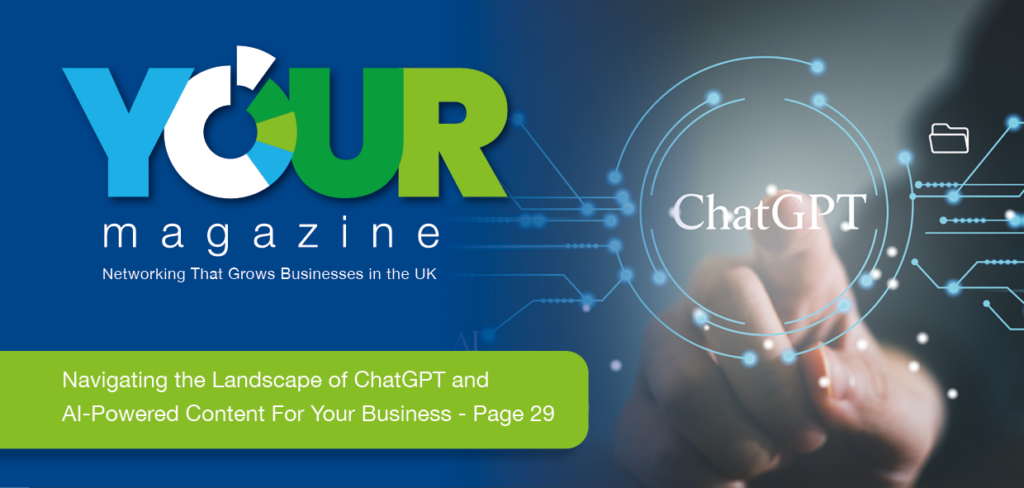This is an article that I wrote for the Your Partnerships magazine recently, looking at the benefits and down-sides of using AI – specifically ChatGPT and others like it, for your business’s written content.
Navigating the Landscape of ChatGPT and AI-Powered Content For Your Business
Anyone paying attention to tech developments recently will have heard of ChatGPT, and anyone reading Your Partnerships emails and social posts recently may have seen it in action, in the form of the AI-generated content powered by FunkyMedia.ai, which is based on ChatGPT.
So, what is it, is it any good, and can it help your business?
ChatGPT and its friends
ChatGPT is a large language model based chatbot, able to produce text based on user prompts, drawing answers from data mining the information sources that have been fed into its machine learning system. It isn’t sentient, but basically uses an extreme version of predictive text to generate content. Microsoft-funded US Artificial Intelligence research lab OpenAI released ChatGPT in December 2022, free to users, and based on GPT3.5. Their subscription service, using the more advanced GPT4 is also available now, and integrates with Bing Chat to search the web. Google’s BardAI is a similar tool, and each of these has different strengths and weaknesses.
Why use ChatGPT in your business?
Saving time, simplifying tedious tasks or extensive information, and producing text that can be quickly shared are all things that ChatGPT excels at. You can give it a prompt, and it will generate social media content, or précis a long document, or explain difficult concepts in simple terms, saving you, as a business owner, a chunk of time and energy.
FunkyMedia.ai’s interface has been offered to YP Ambassadors to produce their social posts, since July 2023, generating not only text but audio, AI-generated art, text-to-speech AI, and text-to-video presentations featuring avatars, to promote their YP events, combining the functionality of several different AI applications into a single platform.
Prompts can be tweaked, easily making the language more or less formal, shorter, longer, with bullet points, or more like a pirate – Aye matey!
Questions around ChatGPT
As ever with new technology, especially something that is evolving rapidly and has exploded into popular usage as fast as this has, there are questions that need to be answered.
One is around academic ethics. Many universities in the UK have banned ChatGPT, citing fears of plagiarism, and students turning in essays that they haven’t written themselves. Software that aims to detect AI-generated content has proven unreliable to date, flagging a high percentage of false-positives, as well as missing AI content it should have spotted.
Another issue arises because large language models are only as good as the information from which they have mined their data. Where the source is biased, then the output will also be biased – it’s as simple as that. And where the source is inaccurate, then the output will reflect that – but with the end user unable to verify the sources, and maybe unaware that the output isn’t correct.
There are also lawsuits in progress alleging that OpenAI used copyrighted books without permission to train its AI systems, as well violating privacy laws by illegally mining personal data. However, these are bigger-picture issues at present, and we can leave those to the policymakers and regulators at this point!
What issues might affect my business?
There are a few known hiccups with ChatGPT, which it might be useful to be aware of, if you’re intending using it to generate blog content, or write reports for your business.
1 – we’ve touched on already – is that the output is only as good as the input. The data sources may be biased, and ChatGPT is notorious for being confidently incorrect. It’s known for ‘hallucinating’ answers to questions, and unless you check everything very carefully, you could be telling your customers incorrect information.
2 – your input needs to be good as well. As a very simplified example, if you ask for ‘an article about rabbits’ then you’re leaving it to the AI to determine whether you mean pet rabbits, wild rabbits, or rabbits for casserole! (And how long the article needs to be, in what style, and who the target audience is.) Tweaking your input will result in adjustments to the output, which will arrive at an outcome more closely aligned to what you wanted, and learning how to do that is a skill.
3 – you’re missing the human touch. AI will never give a true human perspective, and it’s also incapable of humour, sarcasm, irony, puns, or metaphors. The best way to truly connect with your customers is to be yourself, a real human being, so relying on AI for important customer interactions could mean that you’re missing out.
4 – the free version of ChatGPT can’t access the internet. Its data is drawn from sources prior to September 2021, so it has no idea who the current UK prime minister is, for example, nor can it give current data on anything. The subscription version can access up-to-date information, but not everyone can justify $20 per month.
So, in a nutshell, ChatGPT and its friends could be a tremendously useful tool for many businesses, but handle with care.
See also this article that I wrote for Your Partnerships, about their vans, and the sponsors who are features on them. The style was deliberately written to be outside of the realm of what ChatGPT can accomplish!


Leave a Reply